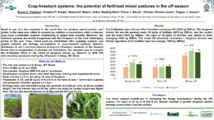Crop-Livestock Systems: the potential of fertilized mixed pastures in the off-season.
Crop-Livestock Systems: the potential of fertilized mixed pastures in the off-season.
Autoria: PEDREIRA, B. C. e; ARAÚJO, G. P.; MATOS, B. F.; BEHLING NETO, A.; WRUCK, F. J.; OLIVEIRA JUNIOR, O. L. de; GOMES, F. J.
Resumo: The livestock systems are mostly forage-based and the off-season is the most challenging period of the year in Brazil. Mixed pastures established after cropping soybean can greatly enhance the herbage accumulation in crop-livestock systems. Besides, fertilization is not a common practice during the off-season, although, in the Amazon Biome, there is no temperature or photoperiod restrictions. Our objective was to evaluate the fertilization effect on the mixed of Sorghum bicolor (L). Moench cv. BRS 810 with Urochloa ruziziensis during the off-season in Sinop, MT, Brazil. The experiment was planted after soybean harvest, on 10 Mar. 2020, at the Embrapa Agrossilvipastoril, Sinop, MT, Brazil. The experimental design was a randomized complete block with three fertilizations inputs and three replicates. The thee treatments were 0 (control), 25, and 50 kg/ha of N and K in the form of urea + ammonium sulphate and potassium chloride, which were applied on 2 April. Herbage mass was harvested using three quadrats (0.5 m2) per plot, at 20-cm stubble height, to calculate herbage accumulation (HA). The plots were harvest on 20 Apr. (when the sorghum canopy height was higher than 120 cm), 18 May and 15 June. The fertilization rate did not affect Urochloa ruziziensis HA (3505 kg DM/ha). The Sorghum bicolor HA was the greatest under 25 kg/ha of fertilizer (4870 kg DM/ha), and the control was the least (3435 kg DM/ha). The input of 50 kg/ha of fertilizer was similar to both, averaging 4240 kg DM/ha. The mixed HA (Urochloa ruziziensis + Sorghum bicolor) was similar regardless of the fertilizer input (on average, 7690 kg DM/ha). We concluded that 25 kg/ha of fertilizer increased Sorghum bicolor HA improving the forage budget during the off-season.
Ano de publicação: 2020
Tipo de publicação: Resumo em anais e proceedings
Unidade: Embrapa Agrossilvipastoril
Palavras-chave: BRS 810, Brachiaria Ruziziensis, Lavoura, Livestock, Mato Grosso, Pastagem Mista, Pastures, Pecuária, Sinop-MT, Sorghum bicolor subsp. bicolor, Soybeans, Urochloa ruziziensis
Observações
1 - Por padrão são exibidas publicações dos últimos 20 anos. Para encontrar publicações mais antigas, configure o filtro ano de publicação, colocando o ano a partir do qual você deseja encontrar publicações. O filtro está na coluna da esquerda na busca acima.
2 - Para ler algumas publicações da Embrapa (apenas as que estão em formato ePub), é necessário ter, no celular ou computador, um desses softwares gratuitos. Sistemas Android: Google Play Livros; IOS: iBooks; Windows e Linux: software Calibre.
Acesse outras publicações
Acesse a Base de Dados da Pesquisa Agropecuária (BDPA) para consultar o acervo completo das bibliotecas da Embrapa.

